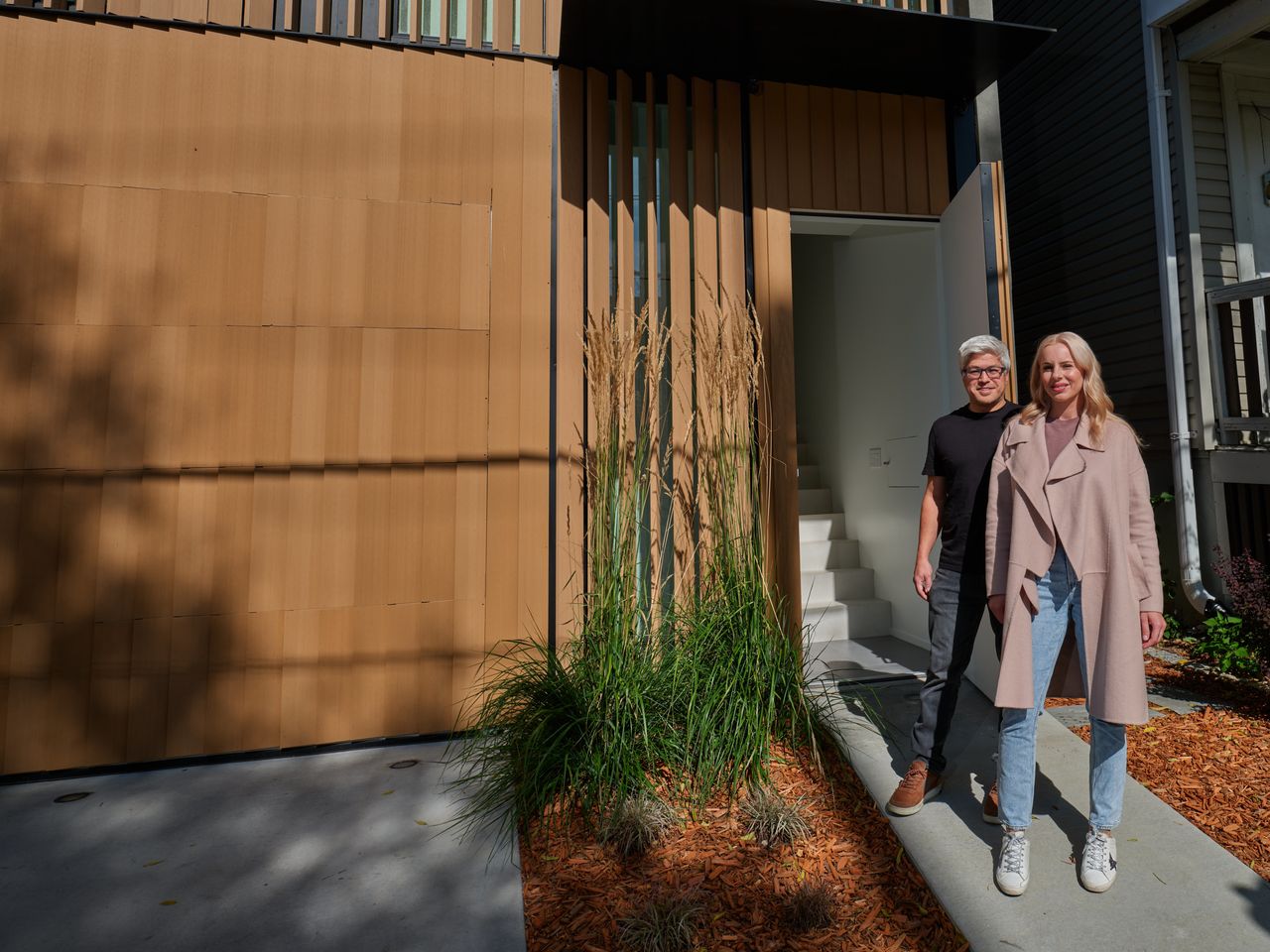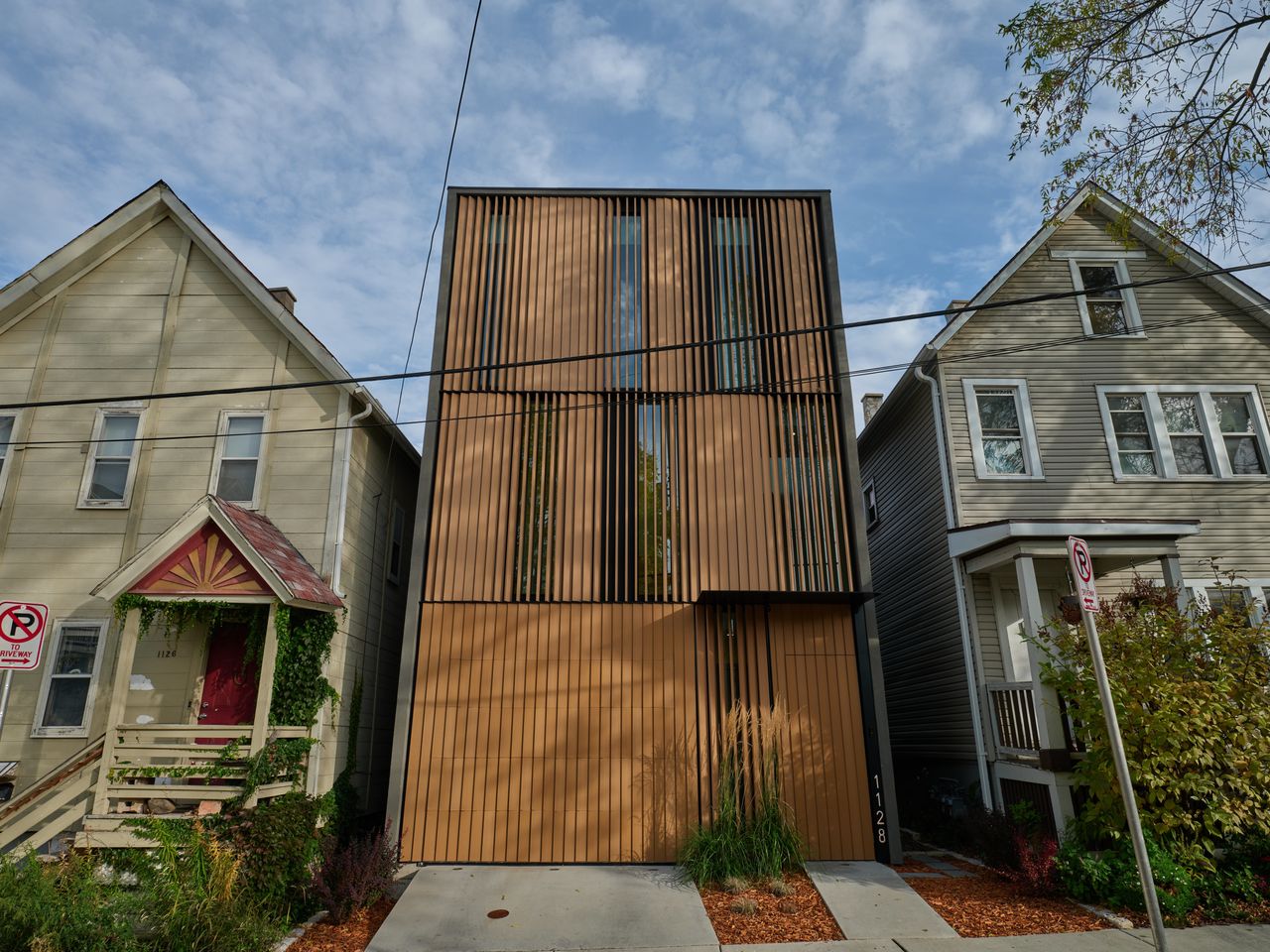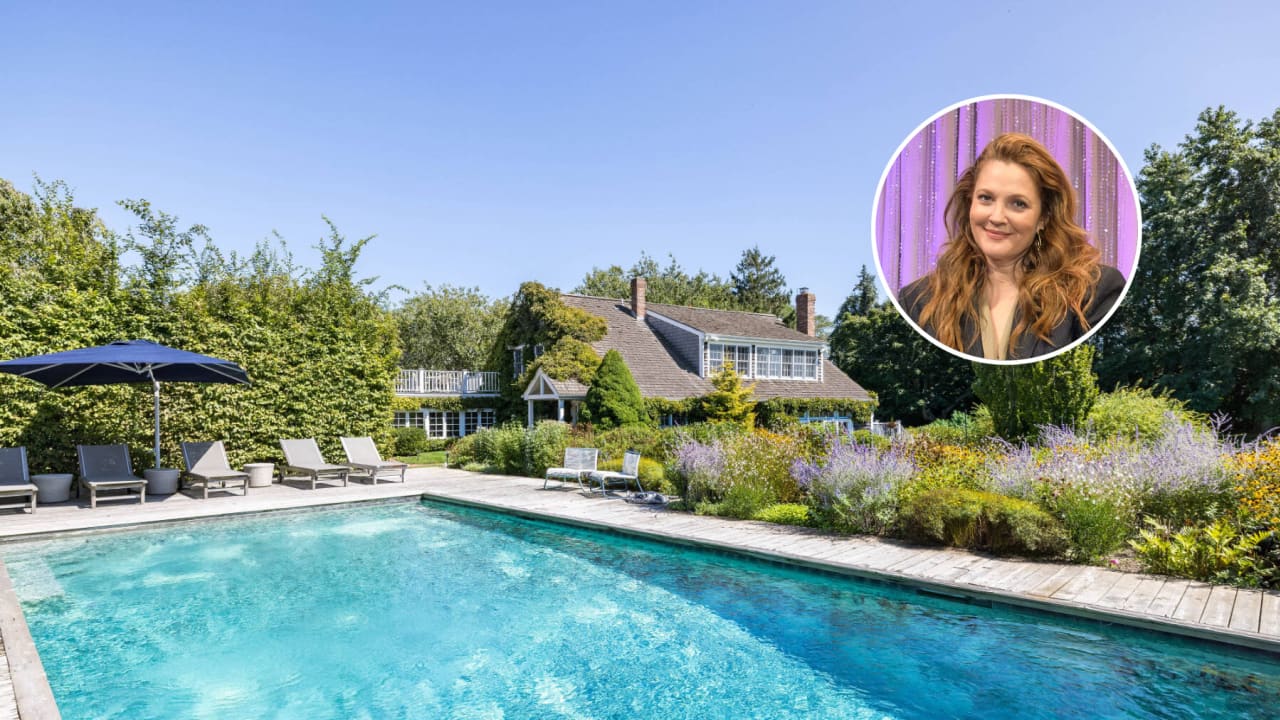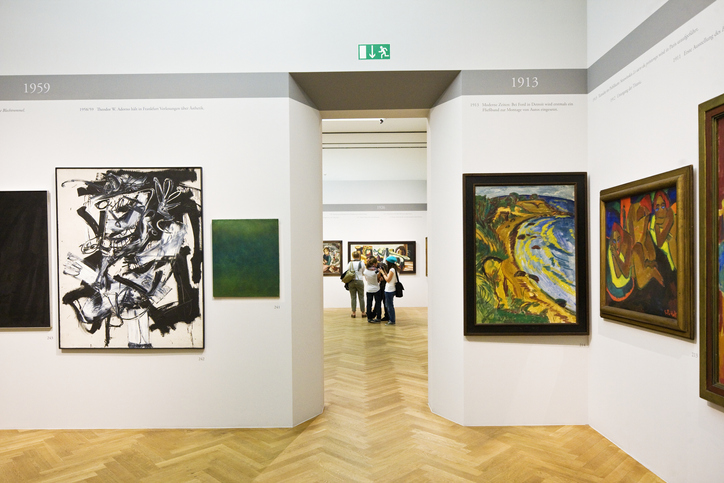This Couple’s Milwaukee Home Lets Them Live Separately. They Couldn’t Be Happier.
Jason Kuwayama and Leah Busse share a bedroom but enjoy their own space inside the modern property on the city’s Lower East Side
Jason Kuwayama hardly ever goes to the front section of the new house he built in downtown Milwaukee’s Lower East Side. That is where his girlfriend, Leah Busse, plays “Call of Duty” in her designated game room—a space filled with her collectibles and art.
Instead, Kuwayama, an attorney, enters through the back of the house and spends most of his time in the main living area, an open, light-filled space with no clutter.
The two sections of the house are separated by a long hallway and an outdoor courtyard.
It is a similar scenario upstairs, in the primary suite: The two share a bedroom, but Kuwayama’s pristine bathroom is down a long hallway, and separated by the laundry room, from Busse’s, which is usually filled with clothes.
This arrangement suits them both well.
“My style is reductionist. I am a bit fastidious,” says Kuwayama, 43, who spent around $1.9 million building the house over 3½ years, finishing in 2021.
“I am a mess monster,” says Busse, 38, who works for a home-building company. “Jason wanted me to have my own space that he didn’t have to see.”
The separation between the front of the house and the back was part of a larger scheme for the house, designed by Brian Johnsen and Sebastian Schmaling of Milwaukee-based Johnsen Schmaling Architects to help create privacy in a demographically dense location.
Kuwayama bought the long, narrow—24-foot-wide—infill lot for $35,000 from Milwaukee’s Department of City Development. It sits tightly between two other houses and the setback is right up to the edge of the sidewalk, a requirement of the city aimed at preserving the neighbourhood’s character. Most of the other homes on the street are traditional, two-level structures with pitched roofs built as affordable housing a century ago—and most have the drapes drawn on their front windows to block prying eyes.

To allow the same privacy as those drapes but still let in light, Johnsen Schmaling came up with an exterior facade that acts as an abstract curtain, with slanted fins made from a hybrid of wood and aluminium. The tightly spaced vertical louvers are installed at gradually rotating angles with various degrees of openness, in part to imitate the movement of curtains and to respond to whether there’s glass or solid wall behind it.
“It creates a sense of mystery,” says Brian Johnsen, whose firm dubbed it Curtain House. The fins also act as a sun-shading device to protect the home from overheating in the summer.
A courtyard, bracketed between the front two-story section and the back two-story section, acts both as a buffer and a source of light, since it is open to the sky. Light comes into the house through the floor-to-ceiling glass windows that line the hallway along one side and the rooms (the kitchen one side, Busse’s game room on the other) on each end.
The main living area is open from the courtyard to the big windows and balcony that look over the river in back, also allowing in flood of light. The kitchen has a white island with an induction range and cabinets without hardware that open with a push, adding to the streamlined effect. The pantry is in back of the kitchen, also behind hardware-less doors.
The staircase, which leads both downstairs to the garage entry and a mud room and a cigar room and upstairs to the primary bedroom, has transparent glass panels supporting the tread on the ascending part, making the main floor feel wider and allowing a view of the river. The furniture is modern and sparse: a sea green Room & Board sofa, a glass Noguchi coffee table and a Barcelona chair.
Outside, the terrace is covered in fine grained rock and has a stairway with three platforms that leads down to the river. It has a pastoral feel, with trees and bushes fringing the property.
Kuwayama’s urban, modern, minimalist, open-plan, colour-free aesthetic is partly a revolt against his childhood home, a French chateau-style house in the Brookfield suburb of Milwaukee. His mother liked wallpaper and carpeting. His father leaned toward teak and Midcentury Modern art. The result was a compromise, with lots of small, separate rooms and bathrooms with their own colour (one avocado green, one brown and one pink).
Busse’s taste veers more toward traditional: an old manor with big wood banisters filled with knickknacks, she says. But she says she wasn’t interested in the design of the house because it was Kuwayama’s project from the start. Working for a home builder, she didn’t want to think about house plans when she was at home—and she wanted to move to a house with a big yard in the suburbs, she says.
Living in inner Milwaukee was also a form of rebellion for Kuwayama. He says when he was a teenager, growing up in the suburbs, it was implicit that he wasn’t to go downtown. After studying undergrad at Northwestern University, in Evanston, Ill., he attended Marquette University Law School, right in downtown Milwaukee, and stayed there after he graduated, eventually buying a condo along the north side of the river, about a half mile from his new house.
The couple met in 2014 on $2 taco night at a local restaurant called BelAir Cantina, when Kuwayama and his friend bought drinks and food for Busse and her friend. Busse promised to meet him at the same place the following week, but never showed. A few weeks later, she saw him at a Starbucks. (Locals call the city “Smallwaukee” because running into people you know is so common). Kuwayama retaliatorily ignored her, but she tracked him down and asked him out.
Busse, along with her dog and cat, moved into Kuwayama’s 1,150-square-foot condo in 2016. They liked living together but the space was too small, says Kuwayama. “You could never get away from anybody. You couldn’t separate at all,” he says. He saw the lot for sale and negotiated the price down from $140,000 to $35,000, in part because the land was so difficult to build on, he says. Kuwayama says the city was supportive of his project, allowing variances, because it wants the neighbourhood to remain single family homes.
Milwaukee has been going through a process of urban revitalisation for decades. Once a centre of manufacturing, attracting immigrants from across the world, Milwaukee’s population hit a peak of 741,324 in 1960, making it the 11th-largest city in the country and a centre of brewing beer. The city was immortalised in the TV show “Laverne & Shirley,” about roommates who worked at a brewery there.
Like many Midwestern cities, Milwaukee was hit hard by the recession in the 1970s and 1980s, while at the same time many of the more affluent residents moved to the suburbs. Over a 30 year period, from 1970 to 2000, due to the relocation of industry and competition from emerging markets overseas, manufacturing employment plummeted by more than 77,000 jobs, and accounting for nearly 95% of all job loss in Milwaukee since 2000, according to the City of Milwaukee. The latest census puts the city’s population at 577,000.
In the 1990s, the city implemented its Riverwalk initiative, a 3-mile pedestrian path that goes along the Milwaukee River, connecting downtown to the Third Ward. The city estimates property values around the path have grown by $1.5 billion since 1993 and moves are under way to expand it.
Architecturally, the city hasn’t evolved as quickly. Polish Flat and German Duplex structures—two-family homes with one unit stacked on top of the other—still dominate the street where Kuwayama built his house. Homes in the area have been increasing in value, up around 25% over the past year as of October 2023, according to Redfin. A few blocks away, a two-bedroom, one-bathroom, 1,160-square-foot, 19th century house that was remodelled sold for $254,000 in September 2023, while a two-bedroom, two-bathroom, 2,662-square-foot unit in a newly renovated condo building with a courtyard sold for $612,000 in July 2023.
Kuwayama says the reaction from people walking by his house (captured on security cameras) is mixed: Some love it, others are put off by the fins on the facade. One guy routinely takes dates through their back deck to their platforms overlooking the river. But he doesn’t mind. “I’m committed to the city of Milwaukee,” says Kuwayama. “Being accessible to the community is part of that.”
 Copyright 2020, Dow Jones & Company, Inc. All Rights Reserved Worldwide. LEARN MORE
Copyright 2020, Dow Jones & Company, Inc. All Rights Reserved Worldwide. LEARN MORE
This stylish family home combines a classic palette and finishes with a flexible floorplan
Just 55 minutes from Sydney, make this your creative getaway located in the majestic Hawkesbury region.
Companies are leasing premium office space to entice workers back, but employees in one major capital are holding out
The post-COVID return to CBD offices continues across Australia, with the average office occupancy rate climbing to 76 percent of pre-pandemic levels in the first quarter of 2024, according to new CBRE figures. Workers are gradually responding to their employers’ requests to attend their offices more regularly to enable greater collaboration with workmates. The occupancy rate has risen from 70 percent in the December quarter and 67 percent 12 months ago.
Occupancy rates improved across all capital cities during the March quarter, with Perth and Adelaide maintaining the strongest rates of 93 percent and 88 percent respectively. CBRE analysis suggests shorter commuting times and less structured working-from-home arrangements in these cities have contributed to higher rates of return. Brisbane’s occupancy rate is 86 percent of pre-COVID levels, weighed down by a slower return within the public sector, which represents 35 percent of the city’s office space. This same trend is being seen in Canberra, where the occupancy rate is just 66 percent.
In Sydney, the occupancy rate has risen to 77 percent, largely due to major banks and professional services firms pushing for more staff to return to the office this year. There has been a significant increase in workers returning to offices in Melbourne, with the occupancy rate up from 57 percent last quarter to 62 percent now. However, this is still the lowest attendance rate in the capital cities.
Businesses are increasingly pushing workers to return to the office because they are concerned working from home over multiple years will have a negative long-term impact on company-wide productivity. Part of the problem is new employees not having regular access to senior staff so they can learn and work more effectively and productively. CBRE says lower levels of collaboration and interaction reduce innovation, which is a particular concern for technology firms. They were quick to embrace remote working during COVID, but are now seeing dampened creativity among staff.
Tuesday is the peak day for attendance at CBD offices and Friday is the lowest day. Two-thirds of organisations that have moved their corporate headquarters since COVID have chosen to upgrade to premium office buildings, according to CBRE’s research. Premium blocks typically feature retail, restaurants, and recreational amenities on the ground floor, and command a higher rent. Companies are deciding it’s worth the cost to entice workers backand keep them feeling happy and engaged.
Jenny Liu, Director of Workplace Consulting at CBRE, said a vibrant workplace experience is essential.
“A workplace experience isn’t just environment, cool furniture and tech anymore,” she said. “It’s the culture, ways of working, leadership, and how vibrancy is created.”
Some companies are using apps that inform staff who will be in the office tomorrow. CBRE Research Manager Thomas Biglands said:
“It’s important that you achieve a critical mass of visitation so that employees come in and feel as though the office is vibrant and full,” he said.
Some firms are linking salary and promotions to office attendance to reward those workers providing higher contributions to corporate culture and mentoring younger staff.
The rate of return to offices in Australia is much higher than in the United States, where occupancy rates have remained at about 50 percent over the past year. CBRE analysis suggests this may be due to better public transport, shorter commutes and lower inner-city crime rates in Australia.
Just 55 minutes from Sydney, make this your creative getaway located in the majestic Hawkesbury region.
This stylish family home combines a classic palette and finishes with a flexible floorplan






















